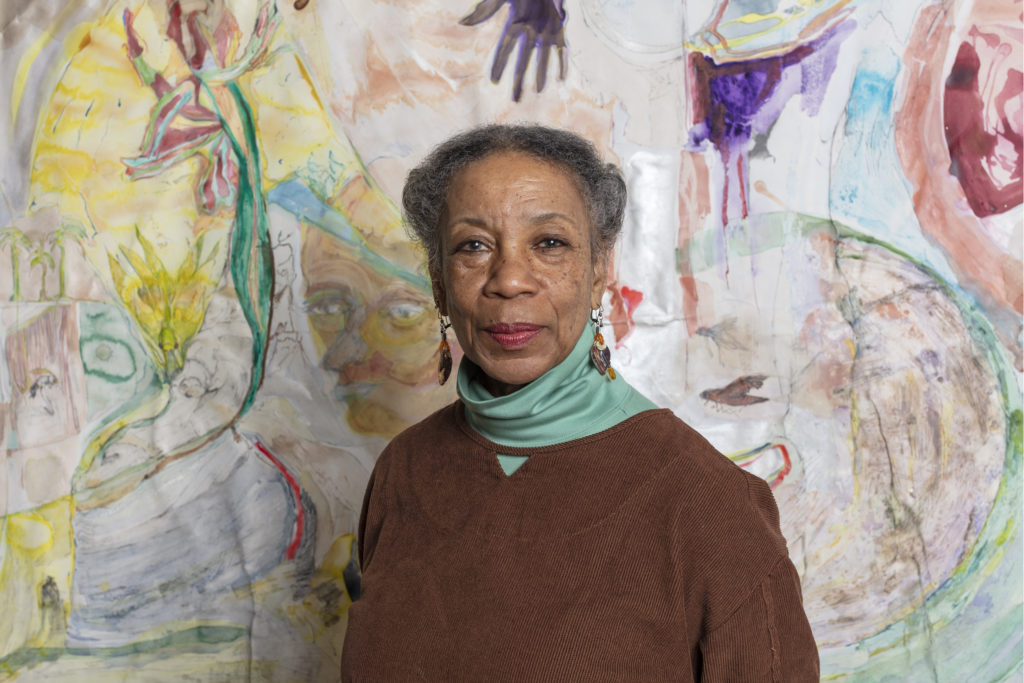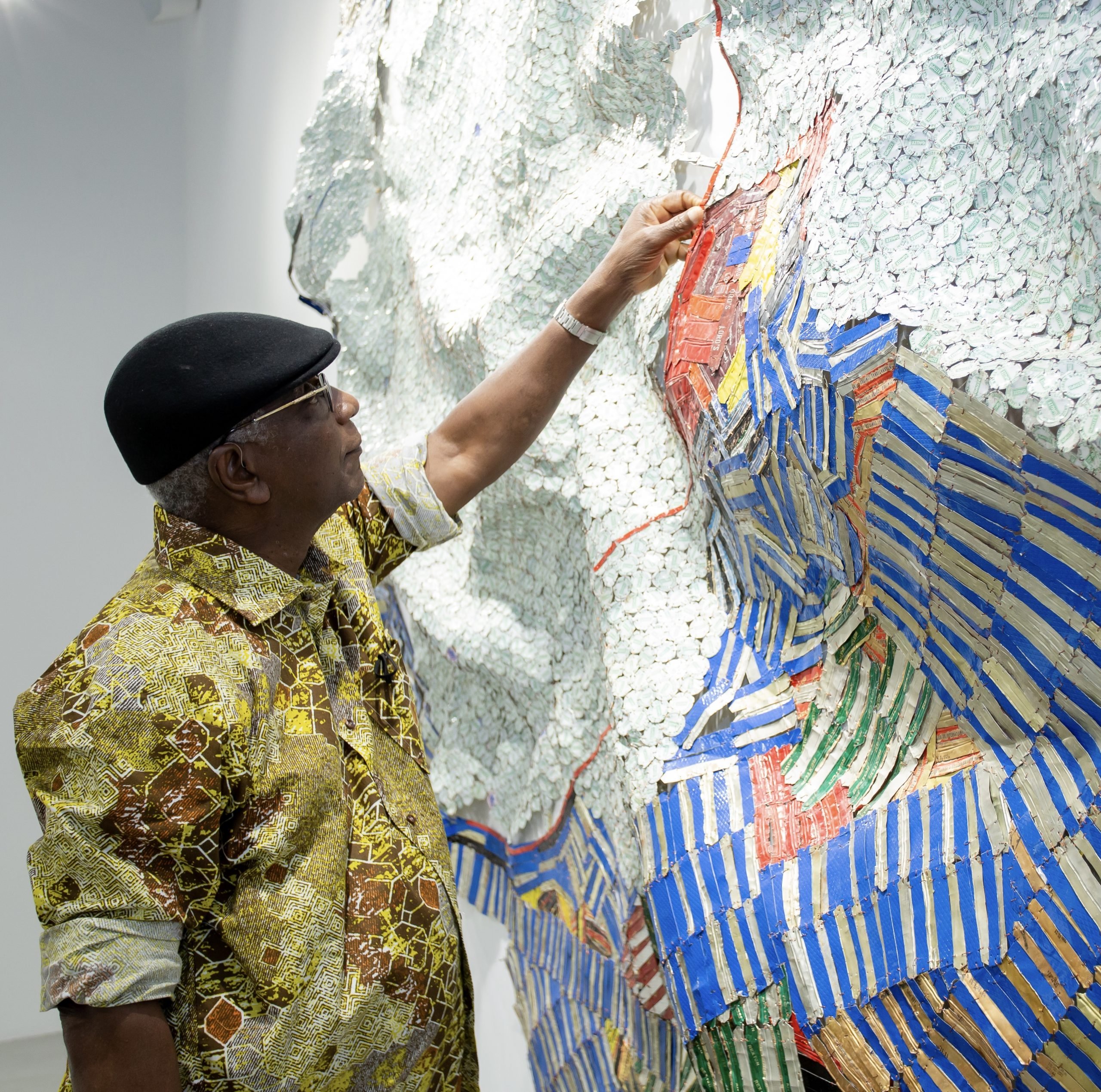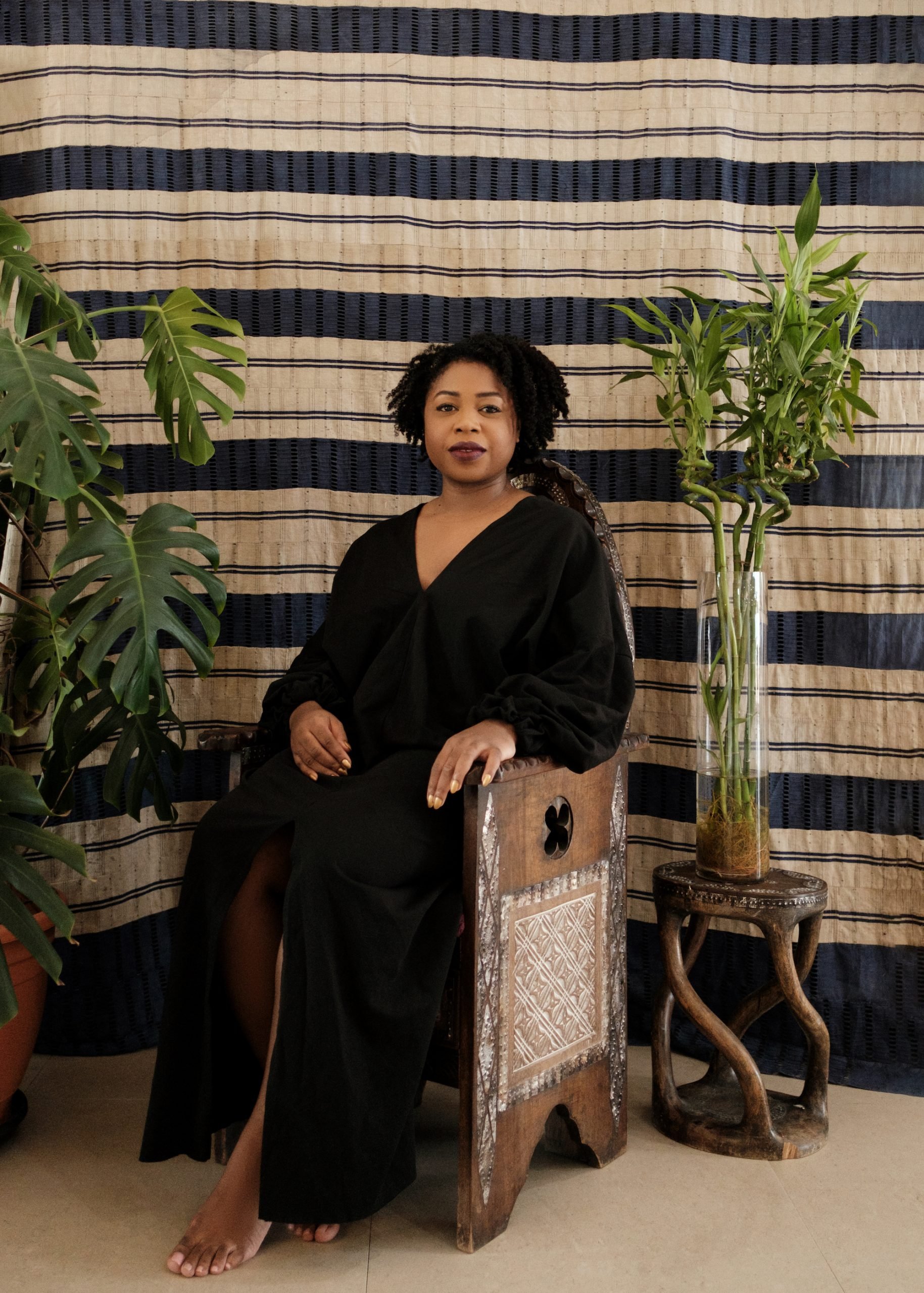Suzanne Jackson never vanished, or, as some people have suggested, ran off to Africa to get married. Instead, the artist and gallerist—who ran a short-lived space in Los Angeles in the late ‘60s that offered early shows to artists including Betye Saar and David Hammons—has been in Georgia. For the past 27 years, she has been teaching students at the Savannah College of Arts and Design and filling up her studio with more and more of her art.
But while she kept busy in Savannah, her work has taken on a life of its own. Gallery 32 was, for years, treated like a non-entity, it was talked about so infrequently. But around 2006, Jackson was surprised to learn that someone associated with the College Art Association conference in Boston asked about the gallery, which operated from 1968 to 1970. She thought, “Well, who else would know about Gallery 32 except me?”
From there, Loyola Marymount University’s Laband Art Gallery put on the show “Gallery 32 & Its Circle,” which provided an in-depth look at Jackson’s influence as a gallerist. And a few years after that, the space took on even more historical weight when it played a starring role in the 2012 exhibition “Now Dig This!: Art & Black Los Angeles, 1960–1980,” organized by the Hammer Museum in LA.
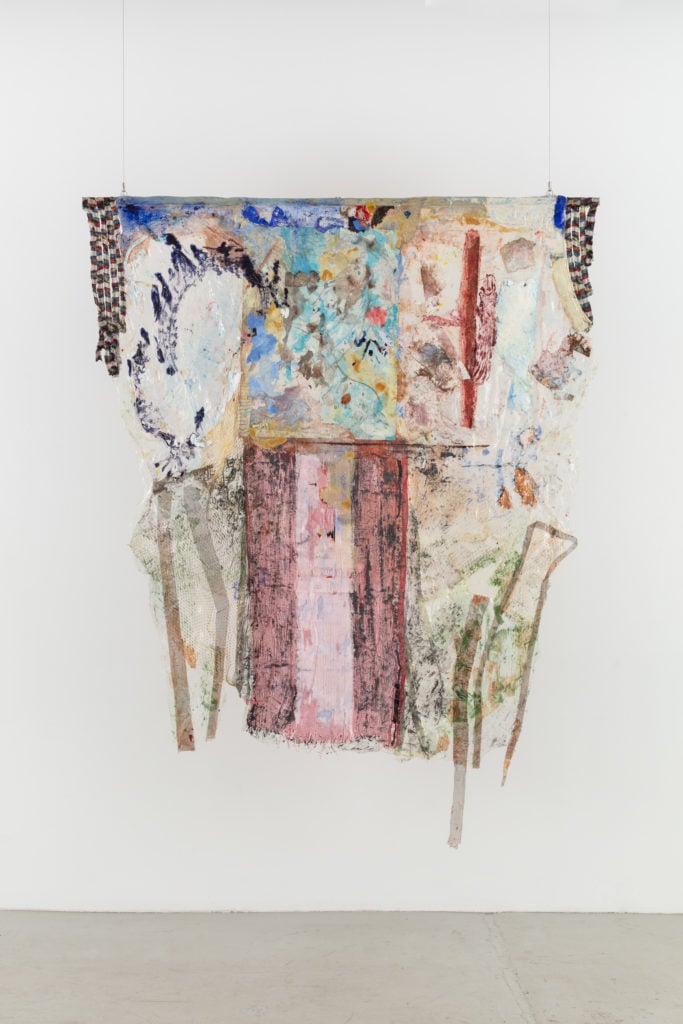
Suzanne Jackson, Silencing Tides, Voices Whispering (2017). Photo: Tim Doyon. Courtesy Ortuzar Projects, New York.
But there is a lot more of Jackson’s story still to tell—and she hasn’t stopped working. She first hit her stride in Los Angeles painting black figures seemingly adrift on the canvas. After moving to Georgia, her work became more abstract. As she watched people living in the South—including those who had struggled more than she could ever imagine—her work began to reflect her impression of who they were, and their intimate thoughts. Jackson’s newer pieces are layered with paper and fabrics, awash in acrylic glaze. Savannah’s intense humidity once made the paper she was using crinkle, which ultimately became another way for her to experiment with texture and line. For Jackson, these pieces have spirit and memory and always seem to reinhabit the shape they were meant to have.
Recently, when Artnet News visited Jackson, who is 75, at Ortuzar Projects in Tribeca, where her first solo show in New York is opening on Wednesday, she explained how the art world has never fully understood how to contextualize her life or work. But now, as gatekeepers are beginning to pay more attention to African American artists who emerged decades ago, people are more interested than ever before. After a jam-packed year, starting with a show at O-Town House—reuniting her with Los Angeles after her decade-long stint showing at the pioneering Ankrum Gallery in the ‘70s —leading into her retrospective at the Jepson Center at the Telfair Museums in Savannah, and now with this show, we have all been given a second chance to finally get her story right.
This year has been quite a whirlwind for you, hasn’t it?
After many, many years of nothing happening.
I mean, in the beginning, it went so fast. In ‘67, I moved to Los Angeles and I was just hearing about things—one photographer at Echo Park was saying, “Well, the guards at the museum are doing this black arts festival.” And then he’d say, “Well, Charles White is teaching at Otis [College of Art and Design], you should take his class.” And I had a BA in painting, and so that was great because none of my professors ever really talked to me. I had a couple critiques but…
Did you say they didn’t really talk to you?
I was basically still self-taught when I left college.
Then I moved to Los Angeles and entered some paintings into the Watts Festival. And the next thing I know, I was invited to show at the Laguna Beach Art Museum. So in 1968, I was in my first museum show, and I sold my first painting for $300. When I think back on that, at 24 years old, that was pretty whirlwind.
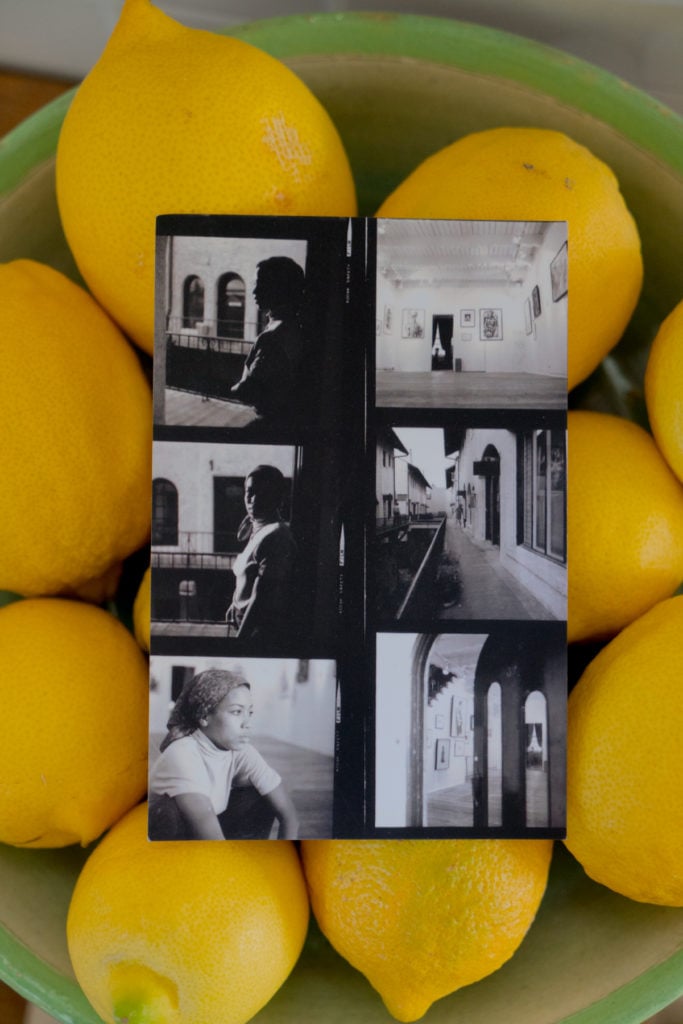
Ephemera from Gallery 32, courtesy of the artist and O-Town House. Photography by Riccardo Banfi.
It sounds like you created a network pretty quickly after moving to Los Angeles.
After taking Charles White’s class, I met [artists] David Hammons and Dan Concholar. They were trying to get me to turn my studio space into a gallery. I just wanted to paint, and they talked me into opening the space.
So how old were you when you opened Gallery 32?
In ‘68, I was 24.
Was it easy to find the community in Los Angeles who wanted to buy the work?
Eventually, once people learned about the artists. Because it was word of mouth; each artist would have people they knew. And I knew people in theater. I also looked in the newspapers and the society pages and business pages, and the Hollywood Variety. People were accessible in those days—the telephone book had names—and the community in Los Angeles was so small because everyone was working in some sort of theater or fine arts.
[After Gallery 32 and a stint in San Francisco,] I moved back to Los Angeles because I visited some friends and there was this great 5,000-square-foot loft. And everybody in that building was an artist. That’s what started the whole downtown art scene that’s there now in LA. [At the time,] there were just not that many artists living in loft spaces in Los Angeles. In the Bay Area, however…
That was the norm?
Yes. I still think about my aesthetic. Because when I was in school, David Park and Diebenkorn and the artists in Northern California—Mary Lovelace O’Neal, Oliver Jackson—they were all painters, painterly painters. And [in LA,] there weren’t that many people painting because of the Watts incident. People were beginning to assemble, like [Noah] Purifoy.
Painting was not accepted in the same way in Los Angeles as it was in the Bay Area. It was like the arts had a totally different aesthetic and attitude.
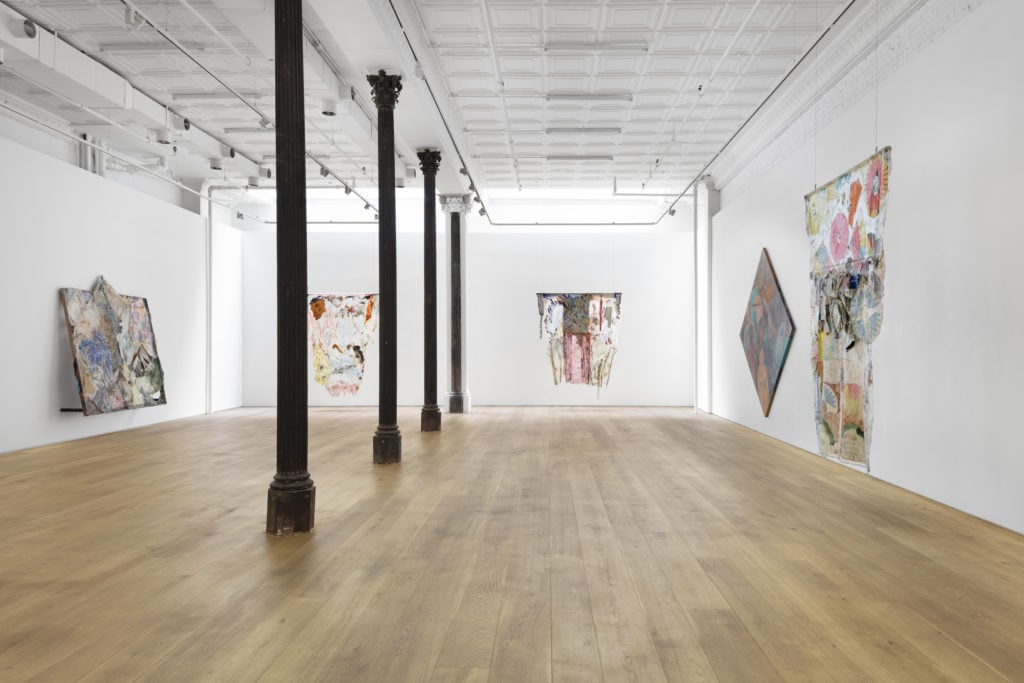
Installation view of “Suzanne Jackson: News!” 2019. Photograph by Tim Doyon. Courtesy Ortuzar Projects.
This show with Ortuzar Projects marks the first the first time you’ve had gallery representation since Ankrum Gallery in the 1970s. What’s that like?
Now, all of a sudden, I have three galleries trying to represent me. And then more people—some galleries that I’ve wanted to show with for years. [But at the same time, amid all this interest], there are people who put their names on for credit and other people are doing all the work. People of color are doing the work. A lot of that is happening now. A lot of people jumping in, suddenly wanting to be our art historians.
I see a circle now that has come around. People thought we were brash and outspoken, but I think young people now are even more.
How do you think your voice was limited in the ‘70s?
Basically I think people want to put us—we, even our folks—want to put us in categories. So, no one has really been able to put me in categories.
Why do you think that is?
Maybe my work is too subtle or something? I think it reflects who I am culturally. Someone made the comment that it’s not black enough.
They said that now?
Yeah, it’s been said again. Back then, I had big black figures—they were floating. Betye Saar wrote the introduction to my catalogue [for the show at the Telfair] and she said, “Well, she has these big black figures that basically are in a white background.” And she gives an interpretation that I’ve never thought about—about these figures in this white world that is really difficult to deal with.
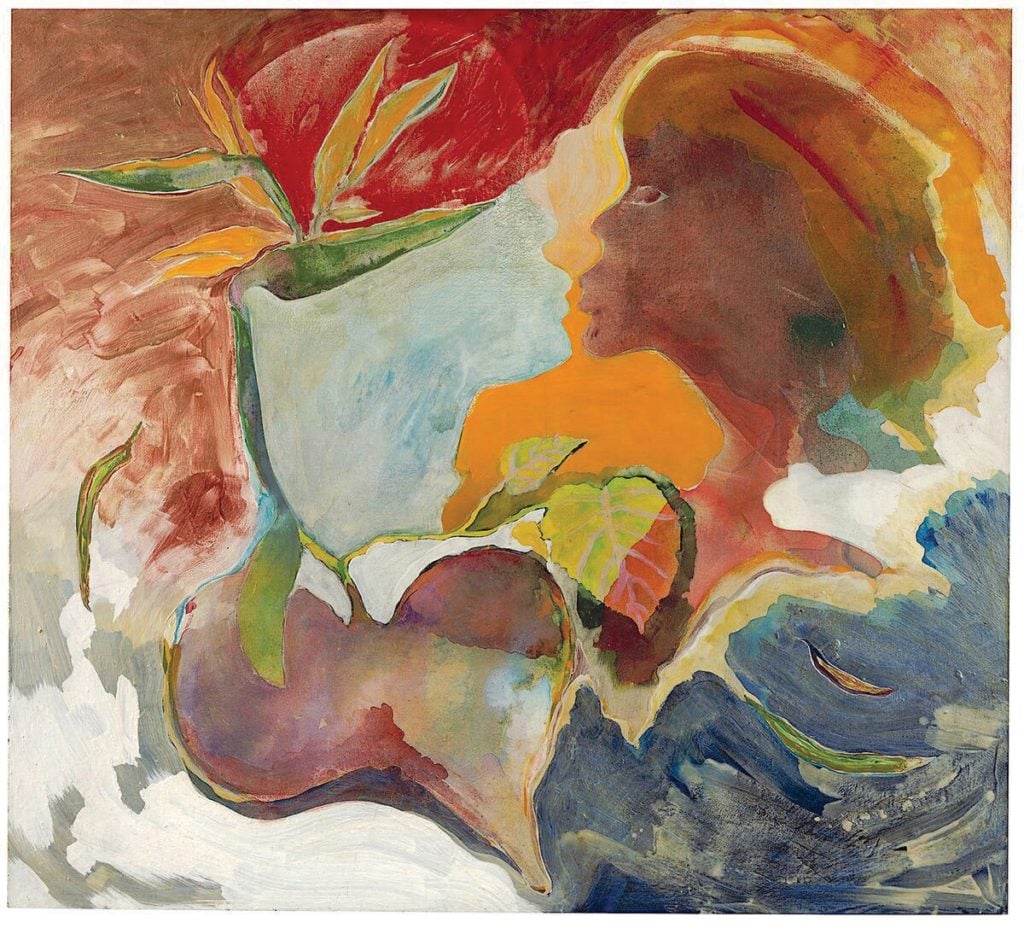
Suzanne Jackson, El Paradiso (1981–84). © Suzanne Jackson. Photo: David Kaminsky, courtesy of Telfair Museums.
I read somewhere recently how the abstract nature of your work is why it hasn’t gotten the recognition it deserves, although the work you made in Los Angeles is clearly figurative.
Up until I moved to Georgia, and no one was paying any attention to me, the work was more figurative. And when I moved to Georgia, I thought I was going to be painting more of the people. And I thought, these are people who went through civil rights, who maybe couldn’t even go to school because maybe their parents or grandparents were protesting. Even though the community took it upon itself to take care of the children and teach them, which is the way I grew up. You didn’t misbehave in the neighborhood, everybody was watching you, even in Fairbanks, Alaska.
So I grew up in that kind of community. Interesting enough, when I moved to the South, in the beginning, everybody, no matter what color they were, would say, “Good morning, how you doing?” Now, there’s no politeness anymore. Because we have people behaving like the person who is supposedly the leader of our country. So now it’s the turn around of thinking okay, now we can take back our privilege that we used to have.
And I’m going to be very blunt about it: Recently, people approached me about my work and wanting to represent it, acting as if they have a right to tell me where I should be placed, and who I should be, and how I should be. And I think, “Oh no, you don’t do that.” I’m getting old enough now that I can be the feisty one if I want. I do not need to be placed in a [category.]
People think that I need to be in exhibitions with certain people in order to be placed, and they were saying, “Well, that’s political, and this is not political, it’s about your spirit.” And no, you have to be interested in looking at the work to understand what I am saying.
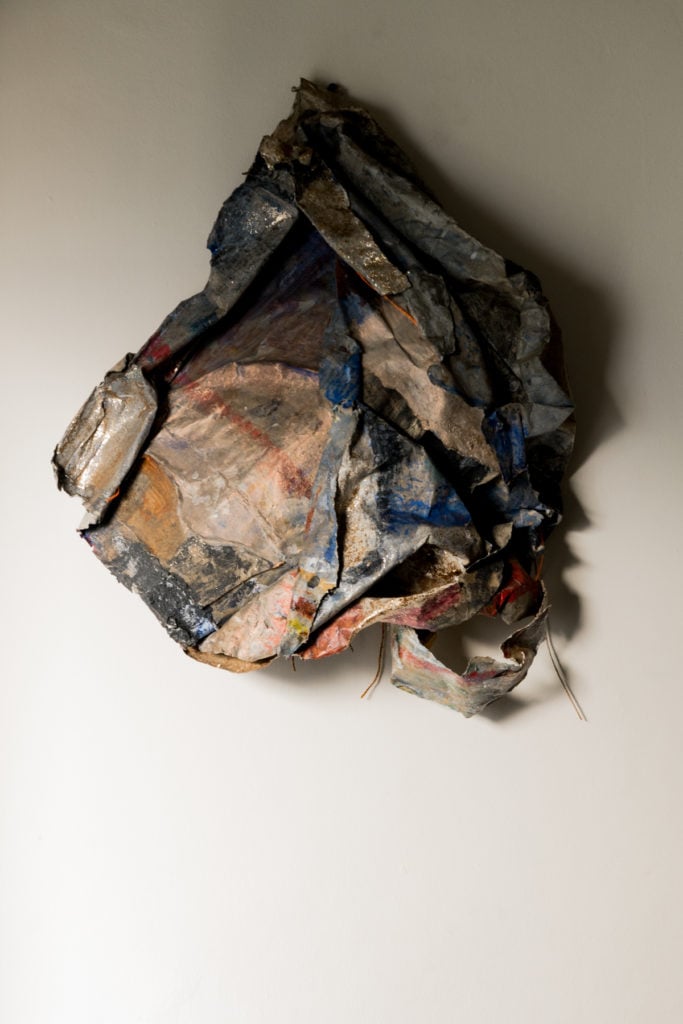
Installation view of Suzanne Jackson’s work at O-Town House. Courtesy of the artist and O-Town House. Photography by Riccardo Banfi.
People give the impression that your newer work is completely abstract, because it’s a little bit outside of what’s obviously figural, but I feel like there are figurative components to it as well, like the one where there is a clear outline of a body.
Especially with the trend that’s happening now where people—it’s almost like photocopying and painting and filling in the blanks. Or collaging. A lot of the younger artists now are doing literal work.
When I was a figurative painter, they were saying, “Oh, you’re not an abstract painter and therefore you’re not relevant.” And when my work gets more abstract, they’re saying, “Well, you’re not figurative.” And I’m thinking, I really don’t care, I have to do what I have to do.
But just going back to what you were saying before, why do you think people have a hard time putting you places, or figuring out where your work fits in?
They want to categorize me. And maybe they won’t when they see this show, because this is new work. Everybody’s been looking at work that’s 40 years old.
I think a number of us artists that they’re now approaching that they ignored years ago, we’re all saying, “We’re tired of people talking about the work from 40 years ago.” But then what I’m understanding is that people feel like the early work we were all doing is now valuable. We were told we weren’t mainstream. We were told that we weren’t relevant because we were black artists.
We are artists.
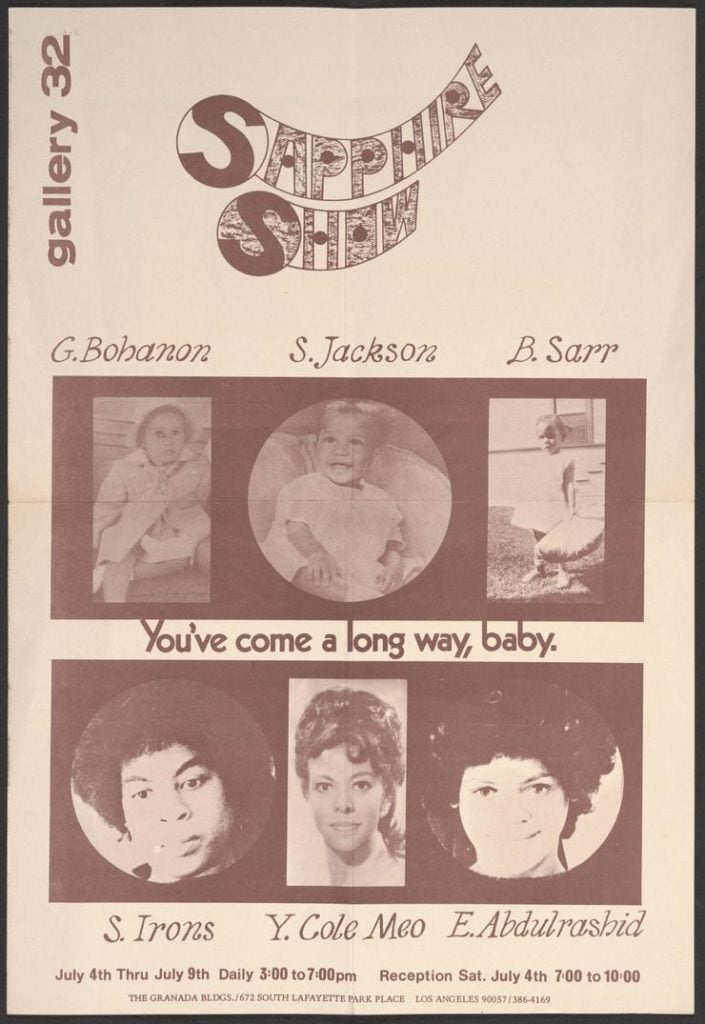
“Sapphire Show: You’ve come a long way, baby” at Gallery 32, July 4–9, 1970. Courtesy of Smithsonian Institute Archives of American Art.
You included Betye Saar in the “Sapphire Show” in 1970 at Gallery 32, which was such an important survey of black women artists working in Los Angeles at the time. Have you seen the Betye Saar show at MoMA?
No, I haven’t yet. I have known Betye forever. She was one of the first artists showing at Gallery 32. I think she was with Jan Baum Gallery, just at the time that we met and before we did the “Sapphire Show” at Gallery 32, and then she switched to another gallery. Some of the other galleries wouldn’t show black artists—or Latino artists, Asian artists, or female artists. There would be only one.
Why was Gallery 32 so short-lived?
Because I had to pay for it out of my pocket. No one was financing me. And I don’t like the way they were saying Gallery 32 folded. It didn’t fold. I actually closed it. John Outterbridge and I had been talking about spaces where art is shown and asking, is a white box the kind of space where art should be?
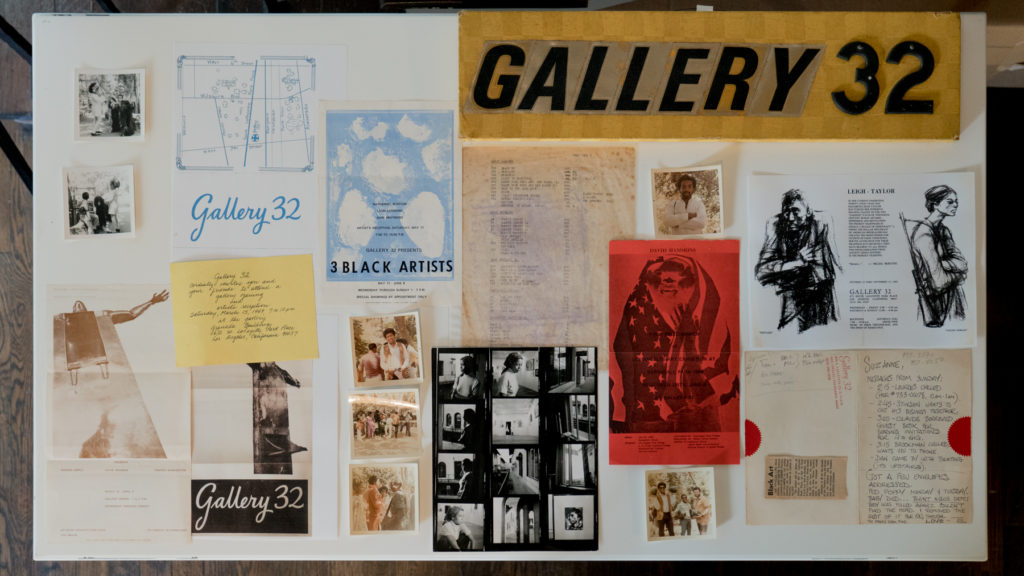
Ephemera from Gallery 32, courtesy of the artist and O-Town House. Photography by Riccardo Banfi.
So was the idea that having kind of a non-traditional space to work and would mean the art could travel further and get into other communities?
That was just some of the ideas. We had lots of big conversations about things. But then, I simply ran out of the ability to keep the gallery open. The rent was $150 a month in those days, but that was still hard.
I was also married and later having a baby. As I said, I went to San Francisco and it just continued. I’ve just never stopped. I’ve been working. I think a lot of people don’t realize I’ve always been working.
That’s what happens when people don’t respect or pay attention to your work at a certain point and then they pick up on it years and years later—they make it seem like that middle period didn’t exist and that you were doing absolutely nothing. Meanwhile, you were probably developing work that entire time.
Well, it was even a surprise in Savannah.
I had students that I had been teaching at the Savannah College of Art and Design for years. The Jepson Center is the contemporary museum that is part of the Telfair Museums [where I had my show]. For 10 years, they had not had a contemporary curator. When Rachel Reese moved there to be the curator, she gave a talk about Nick Cave, who had a tondo in the museum. And she said, “I’m looking for artists who can make big work. And if anyone can make work as big as that tondo…” And I walked up and said, “Hello, I’m Suzanne Jackson. And I make big work.” It turns out other people had told her about me, but no one had been in my studio in all those years I was in Savannah—27 years.
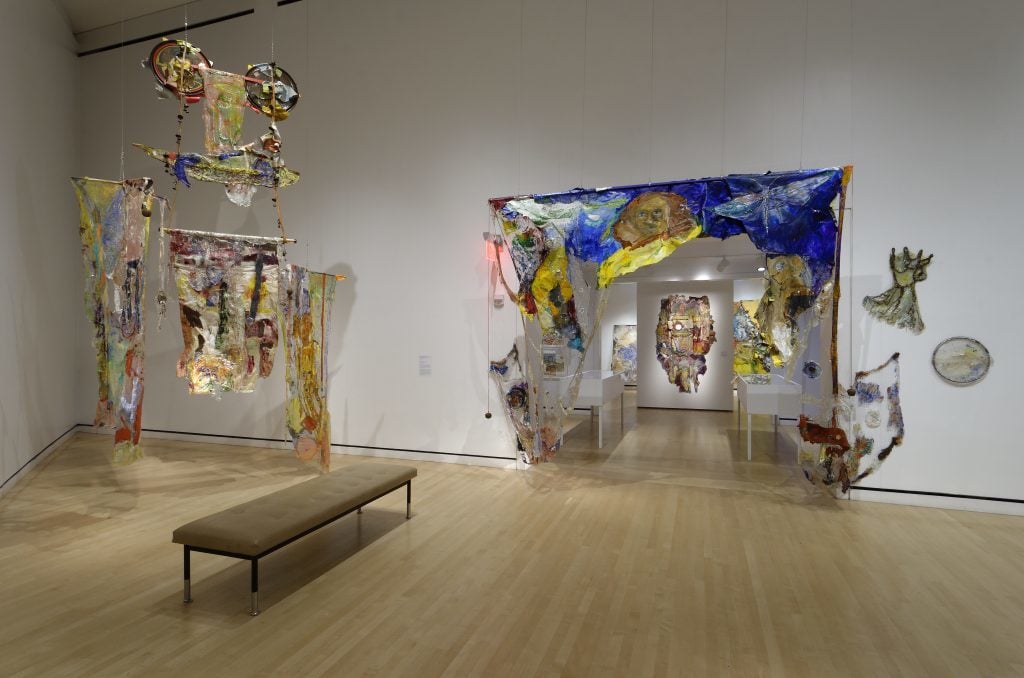
Installation image, “Suzanne Jackson: Five Decades.” Telfair Museums’ Jepson Center, photo: David Kaminsky.
What would you want to happen from here on out?
It would be wonderful if some institutions [acquired my work]—because I work so large. My whole point of working large has always been to put the work in public institutions where people can see them.
People are somewhat encouraged about what’s happening within the community because more institutions are supporting work by black artists.
We did not have any of these advantages [when we were coming up]. I won’t name names, but I remember walking into the museum, up to someone who is supposed to be liberal, and they go, “Yeah, what do you want, I’ve got one minute. I don’t have time.” And that’s the way it used to be.
Young people can’t take this for granted—getting into institutions and having their work purchased.
There have been a lot of blind spots historically.
And that’s how they begin to pigeonhole some of us, and make decisions about what they think we are, who we are. And I’m just glad now—this is exactly what I wanted. I didn’t want the same gallery that everybody else is showing in. I wanted a different philosophy where basically, galleries that aren’t as well known as some of the big names but who support each other.
It’s not just one big gallery becoming one big gallery that also shows all the African American or all the Asian artists.
Like Jack Shainman, who shows a lot of East Coast-based black artists?
At one point I thought, well, that’s the gallery I want to be in. And then I thought, well, everybody’s there already.
And it’s very similar to what we were doing when Alonzo [Davis] was doing Brockman [Gallery, a space dedicated to artists of color open from 1967–89] and I was doing Gallery 32. We each had a different aspect but we supported one another. And then when Linda Goode Bryant opened Just Above Midtown [where Senga Nengudi and Lorraine O’Grady had their first New York solo shows], that was at least five to 10 years later, she was like a teenager and we were supporting her.
I remember when we did the “Sapphire Show” and we were in the women’s building, and the male black artists showed up to support us. There was one white artist there and he was the projectionist.
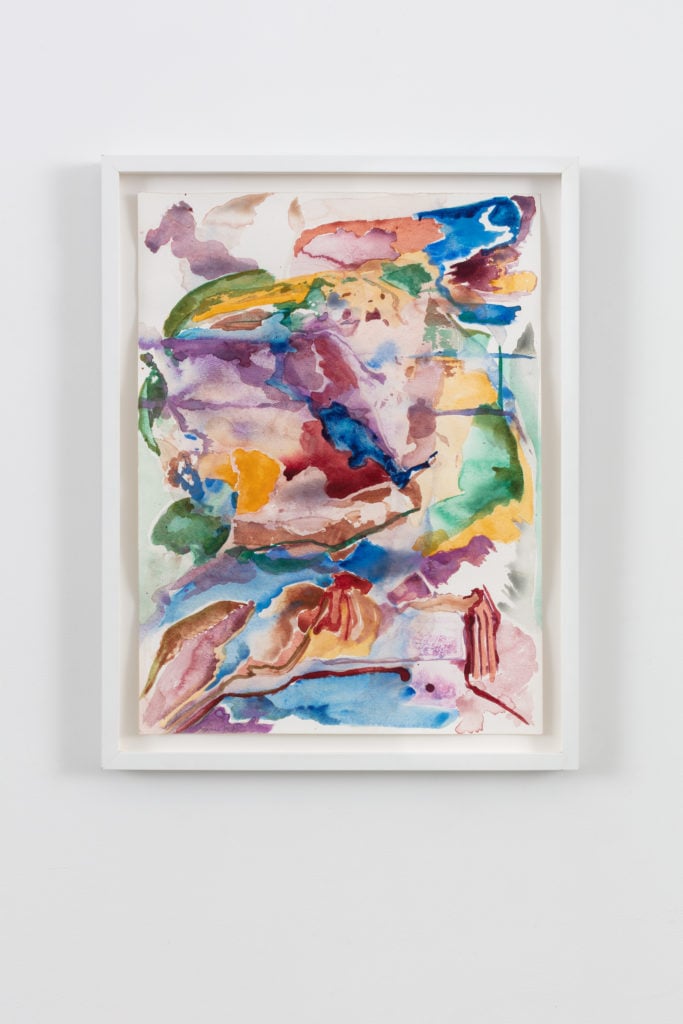
Suzanne Jackson, a little path to paradise (2010). Photo: Tim Doyon, courtesy of Ortuzar Projects, New York.
So he was there to work?
Yeah, and the women were saying, “Well, gee, you’re here?” And they said, “Well, there’s so few of us, we support each other.”
Did people use the fact that you worked as a gallerist as a reason not to pay attention to your work as an artist?
People think that because I worked at a gallery for San Francisco State, that was my relationship to starting Gallery 32, but I had no clue I was ever going to have a gallery.
I guess people don’t like the idea that I don’t call myself a curator or a gallerist. I’m an artist. They put me and a lot of others [in the category] as gallerists because we had galleries. And as a result, people want to keep you as a gallerist as opposed to an artist—we were all artists.
That’s the way it was in those days. We had to do it for ourselves.
Follow Artnet News on Facebook:
Want to stay ahead of the art world? Subscribe to our newsletter to get the breaking news, eye-opening interviews, and incisive critical takes that drive the conversation forward.
